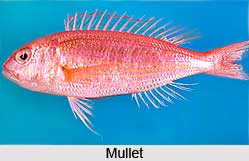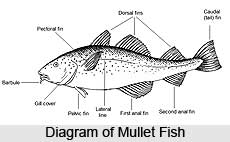 Mullets are a large group of estuarine fishes of the family Mugillidae, two important genera being Mugil and Rhinomugil. They have a small mouth, a rounded snout and a flattened head. They have a soft second dorsal fin, and their lateral line is indistinct or nearly absent. They occur on both the western and eastern coasts of India and the connected estuarine creeks and backwaters. One of the major species, Mugil cephalus, grows to a large size of about a metre, the rest being smaller ones. The adults usually inhabit coastal waters. The exact location of their spawning areas is not yet identified but is expected to be within the coastal belt. On the west coast they breed in the months of March, April and May and after a couple of months the young fry enter the estuarine areas, which are then inundated with rain-water in the early part of the monsoon season.
Mullets are a large group of estuarine fishes of the family Mugillidae, two important genera being Mugil and Rhinomugil. They have a small mouth, a rounded snout and a flattened head. They have a soft second dorsal fin, and their lateral line is indistinct or nearly absent. They occur on both the western and eastern coasts of India and the connected estuarine creeks and backwaters. One of the major species, Mugil cephalus, grows to a large size of about a metre, the rest being smaller ones. The adults usually inhabit coastal waters. The exact location of their spawning areas is not yet identified but is expected to be within the coastal belt. On the west coast they breed in the months of March, April and May and after a couple of months the young fry enter the estuarine areas, which are then inundated with rain-water in the early part of the monsoon season.
Mullets feed on green algae and other small aquatic plants which at that season flourish at the bottom. In clear waters they are seen browsing on this vegetation with tail upwards. They return to coastal water after four or five months, but those that remain after the monsoon water recedes from an important fishery, as mullet is relished by all classes of people. Being vegetable feeders, they constitute an important species for aquaculture on both coasts of India. Chilka Lake on the east coast is well-known for its mullet fishery.
 One species, Rhinomugil corsula, lives mainly in fresh water and breeds there, only occasionally going to estuarine waters. It lives in the rivers of the north-eastern Gangetic plain. Other mullets are bottom feeders, but corsula is a surface feeder. In swampy areas where caddis flies and other insects fly over the surface of water groups of corsula chase them and swallow them in flight. Normally corsula feeds on underwater algal matter. In tidal areas it is seen crawling on mud-flats in search of filamentous algae. When introduced in large numbers into reservoirs it is reported to breed in them.
One species, Rhinomugil corsula, lives mainly in fresh water and breeds there, only occasionally going to estuarine waters. It lives in the rivers of the north-eastern Gangetic plain. Other mullets are bottom feeders, but corsula is a surface feeder. In swampy areas where caddis flies and other insects fly over the surface of water groups of corsula chase them and swallow them in flight. Normally corsula feeds on underwater algal matter. In tidal areas it is seen crawling on mud-flats in search of filamentous algae. When introduced in large numbers into reservoirs it is reported to breed in them.
Red Mullets belong to a different family, Mullidae, which is entirely marine, living near the sea-bottom and found offshore, in the open sea. They are slightly elongated and reddish yellow in colour. They have two fairly long processes or barbell-like structures below the chin which are used for exploring the sea-bottom for food. These outgrowths can be folded when not required. Because of these, red mullets are also known as `goat fish`. In Indian waters, three genera, Mulloidichthys, Parupaneus and Upeneus, are common. They are small fishes about fifteen to twenty centimetres long and are not much valued as food.






































